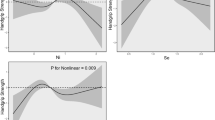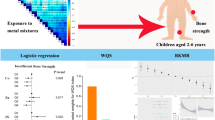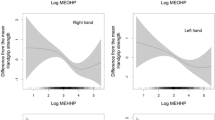Abstract
Human beings are exposed to heavy metals through various ways in daily life. However, the effect of heavy metal mixtures on muscle strength in children and adolescents remains unclear. We aimed to investigate the relationship of exposure to heavy metal mixtures (barium, cadmium, cobalt, manganese, molybdenum, lead, antimony, strontium, tin, thallium, tungsten, uranium, and cesium) with muscle strength in children and adolescents. A total of 1357 (boys, 50.8%) participants aged between 8 and 17 were extracted from the National Health and Nutrition Examination Surveys 2011–2014. Urine metals were measured by inductively coupled plasma-mass spectrometry. Muscle strength was measured through a grip test using a handgrip dynamometer. Weighted quantile sum regression was performed to estimate the mixture effect of urinary metals on muscle strength. After adjusting for potential confounders, comparing participants in the highest versus lowest quartiles of cobalt, molybdenum, lead, antimony, strontium, thallium, and cesium, the handgrip strength decreased by − 4.48 kg (95% CI: − 6.93, − 2.03), − 6.13 kg (− 8.76, − 3.51), − 2.26 kg (− 4.22, − 0.30), − 2.38 kg (− 4.68, − 0.08), − 2.29 kg (− 4.45, − 0.13), − 4.78 kg (− 7.13, − 2.44), and − 5.68 kg (− 9.20, − 2.17), respectively. Furthermore, exposure to a mixture of metals were also significantly associated with decreased muscle strength (β: − 2.62 kg; 95% CI: − 3.71, − 1.54). Findings from the present study suggest that higher heavy metal exposure and the exposure levels of a mixture of metals in urine are inversely related to handgrip strength, implying that children’s grip strength is not entirely explained by energy intake or lack of exercise, but may be related to environmental pollutants.


Similar content being viewed by others
Data availability
Original data can be found in the official website (https://www.cdc.gov/nchs/nhanes/index.htm).
References
Artero EG, Ruiz JR, Ortega FB, España-Romero V, Vicente-Rodríguez G, Molnar D et al (2011) Muscular and cardiorespiratory fitness are independently associated with metabolic risk in adolescents: the Helena study. Pediatr Diabetes 12:704–712. https://doi.org/10.1111/j.1399-5448.2011.00769.x
Agency of Toxic Substances and Disease Registry (2019) ATSDR’s substance priority list in. Available: https://www.atsdr.cdc.gov/spl/. Accessed 16 Dec 2021
Ashrap P, Watkins DJ, Milne GL, Ferguson KK, Loch-Caruso R, Fernandez J, et al. (2021) Maternal urinary metal and metalloid concentrations in association with oxidative stress biomarkers. Antioxidants (Basel) 10. https://doi.org/10.3390/antiox10010114
Barrientos G, Alves J, Toro V, Robles MC, Muñoz D, Maynar M (2020) Association between trace elements and body composition parameters in endurance runners. Int J Environ Res Public Health 17. https://doi.org/10.3390/ijerph17186563
Biltz NK, Collins KH, Shen KC, Schwartz K, Harris CA, Meyer GA (2020) Infiltration of intramuscular adipose tissue impairs skeletal muscle contraction. J Physiol 598:2669–2683. https://doi.org/10.1113/jp279595
Caldwell KL (2012) Laboratory procedure manual. Available: https://wwwn.cdc.gov/n;chs/data/nhanes/2011-2012/labmethods/uhm_g_met_heavy_metals.pdf. Accessed 16 Dec 2021
Carrasco-Rios M, Ortolá R, Rodríguez-Artalejo F, García-Esquinas E (2019) Exposure to secondhand tobacco smoke is associated with reduced muscle strength in us adults. Aging (albany NY) 11:12674–12684. https://doi.org/10.18632/aging.102594
Carrico C, Gennings C, Wheeler DC, Factor-Litvak P (2015) Characterization of weighted quantile sum regression for highly correlated data in a risk analysis setting. J Agric Biol Environ Stat 20:100–120. https://doi.org/10.1007/s13253-014-0180-3
Clark EM, Tobias JH, Murray L, Boreham C (2011) Children with low muscle strength are at an increased risk of fracture with exposure to exercise. J Musculoskelet Neuronal Interact 11:196–202
Duan W, Xu C, Liu Q, Xu J, Weng Z, Zhang X et al (2020) Levels of a mixture of heavy metals in blood and urine and all-cause, cardiovascular disease and cancer mortality: a population-based cohort study. Environ Pollut 263:114630. https://doi.org/10.1016/j.envpol.2020.114630
Edelson LR, Mathias KC, Fulgoni VL 3rd, Karagounis LG (2016) Screen-based sedentary behavior and associations with functional strength in 6–15 year-old children in the United States. BMC Public Health 16:116. https://doi.org/10.1186/s12889-016-2791-9
Eskandari MR, Mashayekhi V, Aslani M, Hosseini MJ (2015) Toxicity of thallium on isolated rat liver mitochondria: the role of oxidative stress and MPT pore opening. Environ Toxicol 30:232–241. https://doi.org/10.1002/tox.21900
Fatouros IG, Jamurtas AZ (2016) Insights into the molecular etiology of exercise-induced inflammation: opportunities for optimizing performance. J Inflamm Res 9:175–186. https://doi.org/10.2147/jir.s114635
Flegal KM, Cole TJ (2013) Construction of LMS parameters for the Centers for Disease Control and Prevention 2000 growth charts. Natl Health Stat Report:1–3
Fraser BJ, Blizzard L, Buscot MJ, Schmidt MD, Dwyer T, Venn AJ et al (2021) Muscular strength across the life course: the tracking and trajectory patterns of muscular strength between childhood and mid-adulthood in an Australian cohort. J Sci Med Sport. https://doi.org/10.1016/j.jsams.2021.01.011
Freire C, Vrhovnik P, Fiket Ž, Salcedo-Bellido I, Echeverría R, Martín-Olmedo P et al (2020) Adipose tissue concentrations of arsenic, nickel, lead, tin, and titanium in adults from Gramo cohort in Southern Spain: an exploratory study. Sci Total Environ 719:137458. https://doi.org/10.1016/j.scitotenv.2020.137458
García-Esquinas E, Navas-Acien A, Pérez-Gómez B, Artalejo FR (2015) Association of lead and cadmium exposure with frailty in US older adults. Environ Res 137:424–431. https://doi.org/10.1016/j.envres.2015.01.013
Gleason KM, Valeri L, Shankar AH, Obrycki JF, Ibne Hasan MOS, Mostofa G et al (2020) Stunting and lead: using causal mediation analysis to better understand how environmental lead exposure affects cognitive outcomes in children. J Neurodev Disord 12:39. https://doi.org/10.1186/s11689-020-09346-x
Hewett P, Ganser GH (2007) A comparison of several methods for analyzing censored data. Ann Occup Hyg 51:611–632. https://doi.org/10.1093/annhyg/mem045
Ilmiawati C, Yoshida T, Itoh T, Nakagi Y, Saijo Y, Sugioka Y et al (2015) Biomonitoring of mercury, cadmium, and lead exposure in japanese children: a cross-sectional study. Environ Health Prev Med 20:18–27. https://doi.org/10.1007/s12199-014-0416-4
Jakubowski M (2011) Low-level environmental lead exposure and intellectual impairment in children—the current concepts of risk assessment. Int J Occup Med Environ Health 24:1–7. https://doi.org/10.2478/s13382-011-0009-z
Järup L (2003) Hazards of heavy metal contamination. Br Med Bull 68:167–182. https://doi.org/10.1093/bmb/ldg032
Khalil N, Faulkner KA, Greenspan SL, Cauley JA (2014) Associations between bone mineral density, grip strength, and lead body burden in older men. J Am Geriatr Soc 62:141–146. https://doi.org/10.1111/jgs.12603
Kim KN, Lee MR, Choi YH, Lee BE, Hong YC (2016) Associations of blood cadmium levels with depression and lower handgrip strength in a community-dwelling elderly population: a repeated-measures panel study. J Gerontol A Biol Sci Med Sci 71:1525–1530. https://doi.org/10.1093/gerona/glw119
König M, Buchmann N, Seeland U, Spira D, Steinhagen-Thiessen E, Demuth I (2021) Low muscle strength and increased arterial stiffness go hand in hand. Sci Rep 11:2906. https://doi.org/10.1038/s41598-021-81084-z
Lang IA, Scarlett A, Guralnik JM, Depledge MH, Melzer D, Galloway TS (2009) Age-related impairments of mobility associated with cobalt and other heavy metals: data from NHANES 1999–2004. J Toxicol Environ Health A 72:402–409. https://doi.org/10.1080/15287390802647336
Maslow AL, Sui X, Colabianchi N, Hussey J, Blair SN (2010) Muscular strength and incident hypertension in normotensive and prehypertensive men. Med Sci Sports Exerc 42:288–295. https://doi.org/10.1249/MSS.0b013e3181b2f0a4
Méndez-Armenta M, Nava-Ruiz C, Fernández-Valverde F, Sánchez-García A, Rios C (2011) Histochemical changes in muscle of rats exposed subchronically to low doses of heavy metals. Environ Toxicol Pharmacol 32:107–112. https://doi.org/10.1016/j.etap.2011.03.001
Moody EC, Colicino E, Wright RO, Mupere E, Jaramillo EG, Amarasiriwardena C et al (2020) Environmental exposure to metal mixtures and linear growth in healthy ugandan children. PLoS ONE 15:e0233108. https://doi.org/10.1371/journal.pone.0233108
Moya J, Bearer CF, Etzel RA (2004) Children’s behavior and physiology and how it affects exposure to environmental contaminants. Pediatrics 113:996–1006
Ng AK, Hairi NN, Dahlui M, Su TT, Jalaludin MY, Abdul Majid H (2020) The longitudinal relationship between dietary intake, physical activity and muscle strength among adolescents. Br J Nutr 124:1207–1218. https://doi.org/10.1017/s0007114520002202
Peterson MD, Saltarelli WA, Visich PS, Gordon PM (2014) Strength capacity and cardiometabolic risk clustering in adolescents. Pediatrics 133:e896-903. https://doi.org/10.1542/peds.2013-3169
Peterson MD, Zhang P, Saltarelli WA, Visich PS, Gordon PM (2016) Low muscle strength thresholds for the detection of cardiometabolic risk in adolescents. Am J Prev Med 50:593–599. https://doi.org/10.1016/j.amepre.2015.09.019
Peterson MD, Gordon PM, Smeding S, Visich P (2018) Grip strength is associated with longitudinal health maintenance and improvement in adolescents. J Pediatr 202:226–230. https://doi.org/10.1016/j.jpeds.2018.07.020
Reynolds P, Canchola AJ, Duffy CN, Hurley S, Neuhausen SL, Horn-Ross PL et al (2020) Urinary cadmium and timing of menarche and pubertal development in girls. Environ Res 183:109224. https://doi.org/10.1016/j.envres.2020.109224
Ruiz JR, Sui X, Lobelo F, Morrow JR Jr, Jackson AW, Sjöström M et al (2008) Association between muscular strength and mortality in men: prospective cohort study. BMJ 337:a439. https://doi.org/10.1136/bmj.a439
Sanders AP, Mazzella MJ, Malin AJ, Hair GM, Busgang SA, Saland JM et al (2019) Combined exposure to lead, cadmium, mercury, and arsenic and kidney health in adolescents age 12–19 in NHANES 2009–2014. Environ Int 131:104993. https://doi.org/10.1016/j.envint.2019.104993
Sayer AA, Kirkwood TB (2015) Grip strength and mortality: a biomarker of ageing? Lancet 386:226–227. https://doi.org/10.1016/s0140-6736(14)62349-7
Shao W, Liu Q, He X, Liu H, Gu A, Jiang Z (2017) Association between level of urinary trace heavy metals and obesity among children aged 6–19 years: NHANES 1999–2011. Environ Sci Pollut Res Int 24:11573–11581. https://doi.org/10.1007/s11356-017-8803-1
Smith MP, Standl M, Berdel D, von Berg A, Bauer CP, Schikowski T et al (2018) Handgrip strength is associated with improved spirometry in adolescents. PLoS ONE 13:e0194560. https://doi.org/10.1371/journal.pone.0194560
Tarp J, Støle AP, Blond K, Grøntved A (2019) Cardiorespiratory fitness, muscular strength and risk of type 2 diabetes: a systematic review and meta-analysis. Diabetologia 62:1129–1142. https://doi.org/10.1007/s00125-019-4867-4
Tchounwou PB, Yedjou CG, Patlolla AK, Sutton DJ (2012) Heavy metal toxicity and the environment. Exp Suppl 101:133–164. https://doi.org/10.1007/978-3-7643-8340-4_6
Vecchi Brumatti L, Rosolen V, Mariuz M, Piscianz E, Valencic E, Bin M et al (2021) Impact of methylmercury and other heavy metals exposure on neurocognitive function in children aged 7 years: study protocol of the follow-up. J Epidemiol 31:157–163. https://doi.org/10.2188/jea.JE20190284
Violante ACV, Perelomov L, Caporale AG, Pigna M (2010) Mobility and bioavailability of heavy metals and metalloids in soil environments. J Soil Sci Plant Nutri 10:268–292
Wang X, Mukherjee B, Park SK (2018) Associations of cumulative exposure to heavy metal mixtures with obesity and its comorbidities among U.S. adults in NHANES 2003–2014. Environ Int 121:683–694. https://doi.org/10.1016/j.envint.2018.09.035
Wolfe AM, Lee JA, Laurson KR (2020) Socioeconomic status and physical fitness in youth: findings from the NHANES national youth fitness survey. J Sports Sci 38:534–541. https://doi.org/10.1080/02640414.2020.1713688
Xu Y, Wei Y, Long T, Wang R, Li Z, Yu C et al (2020) Association between urinary metals levels and metabolic phenotypes in overweight and obese individuals. Chemosphere 254:126763. https://doi.org/10.1016/j.chemosphere.2020.126763
Yates T, Zaccardi F, Dhalwani NN, Davies MJ, Bakrania K, Celis-Morales CA et al (2017) Association of walking pace and handgrip strength with all-cause, cardiovascular, and cancer mortality: a UK Biobank observational study. Eur Heart J 38:3232–3240. https://doi.org/10.1093/eurheartj/ehx449
Acknowledgements
The authors of this manuscript certify that they comply with the ethical guidelines for authorship and publishing in the Environmental Science and Pollution Research.
Funding
This research was not funded by a specific project grant.
Author information
Authors and Affiliations
Contributions
M.W.: conceptualization, methodology, data curation, and writing—original draft. Y.S.: conceptualization and writing—original draft. Y.W.: data curation and writing—reviewing and editing.
Corresponding author
Ethics declarations
Consent to participate
Informed consent was obtained from all individual participants included in the study.
Consent for publication
The authors affirm that human research participants provided informed consent for publication of the aggregate data produced in the study.
Conflict of interest
The authors declare no competing interests.
Additional information
Responsible Editor: Lotfi Aleya
Publisher's note
Springer Nature remains neutral with regard to jurisdictional claims in published maps and institutional affiliations.
Rights and permissions
About this article
Cite this article
Wu, M., Shu, Y. & Wang, Y. Exposure to mixture of heavy metals and muscle strength in children and adolescents: a population-based study. Environ Sci Pollut Res 29, 60269–60277 (2022). https://doi.org/10.1007/s11356-022-19916-2
Received:
Accepted:
Published:
Issue Date:
DOI: https://doi.org/10.1007/s11356-022-19916-2




